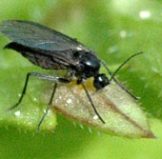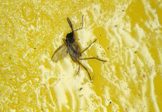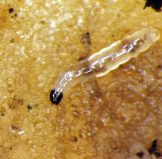
Fungus Gnat. Credit CSU Extension Service
Houseplants, especially ones that we keep outdoors in the warm season and bring back inside when frosts threaten, are likely to harbor Fungus Gnats. These tiny black flying insects (about the size of a fruit fly) can be very annoying but are mostly harmless. Adults lay 75 to 200 eggs that hatch in a week in the top 1” of soil, and when the larvae hatch, they survive mostly on soil fungi, but also feed on tender root hairs. This life cycle lasts about five weeks, although the adults only live about five days. One plant infested with fungus gnats will easily and rapidly spread the insects to nearby plants.

Fungus Gnat on sticky card. Credit CSU Extension Service
Fungus gnats are attracted to overly moist soil full of decaying plant matter. If the infestation is new, letting the top few inches of soil of affected plants dry out completely should desiccate the eggs and kill larvae. If the infestation is already established, you can catch the adult gnats by inserting yellow ‘sticky traps’ on short sticks or wires just above the soil level – bright yellow card stock with a very sticky coating. This will control the adult gnats but won’t affect the eggs and larvae.

Fungus gnat larva on potato slice. Credit CSU Extension Service
The CSU Extension Service recommends capturing larvae by placing a half-inch thick slice of potato on the soil surface. The potato and shiny white, worm-like larvae with a dark head can then be discarded.
Brandi Spade, an assistant editor of Fine Gardening magazine, offers the following safe two-step process, said to eliminate the entire problem.
“STEP 1: Make the Sand Trap
Gather the affected houseplants, remove the top 2” of potting mix to dispose of the eggs and hatched larvae. Discard the soil immediately, and replace this top layer with dry builder’s sand, which is free of organic matter and dries quickly, making an unappealing medium for fungus gnat eggs. Let the soil below dry out completely before the next watering. This should eliminate all fungus gnat larvae and prevent new eggs being laid.
STEP 2: Set up the Open Bar
The adult gnats are easy to lure and drown using any sweet liquid that smells of decay. A cheap bottle of alcohol-free wine works well for bait. Pour the liquid into a small saucer or bowl and place it near the previously infected plant(s). Let it sit overnight, and in the morning, there should be dead gnats floating on the surface. Discard and refill the saucers until the adult gnats no longer appear.”
